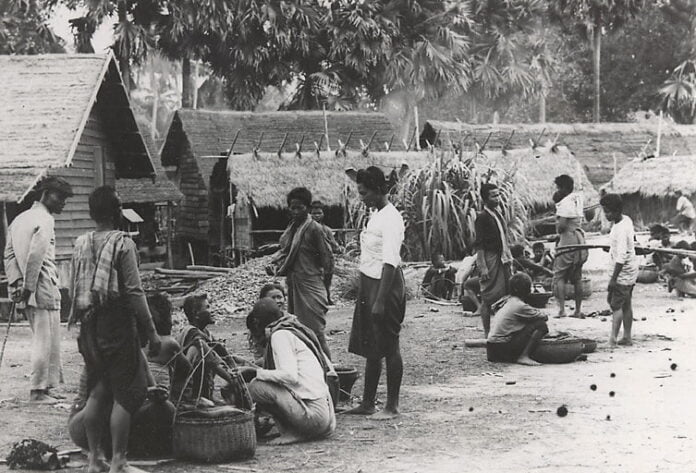Very little is known about the history of Siem Reap. There are few written sources available for reference. Following the era of the Khmer empire, Cambodia was invaded multiple times by Thailand, and for many years Thailand held suzerainty over Cambodia. The history of Siem Reap is closely linked to Cambodia’s battle for control over its territory.
A popular story of Siem Reap’s history centers around King Ang Chan, who ruled Cambodia in the 16th century. King Ang Chan was forced to flee to Thailand (an area then referred to as “Siam”) when his brother usurped the throne. When in Thailand, the Thai King Maha Chakrapat refused Ang Chan permission to return to Cambodia and reclaim his throne. Ang Chan tricked Maha Chakrapat into giving him permission by promising he would hunt and capture a magnificent white elephant that the Thai King had heard about. Ang Chan returned to Cambodia, raised an army and took back the throne. When the Thai King demanded the sought-after white elephant, Ang Chan refused, ending the spell of suzerainty. Maha Chakrapat invaded but Ang Chan defeated the 10,000-strong Thai army. He named the area of the victory “Siem Reap” which means the “flat defeat of Siam”.
French Protectorate
From the 16th to 19th century, Cambodia suffered a period of decline known as the “dark ages” of Cambodia when much territory was lost to their neighbors Thailand and Vietnam. It was not until King Norodom negotiated a treaty with the persuasive French that Cambodia began to retain some of its lands. Siem Reap suffered an uncertain fate however, as the French continued to both battle and negotiate with Thailand and Vietnam for some years. Siem Reap, along with Battambang and Sisophon were under Siamese administration known as Inner Cambodia from 1795 till 1907 until the province was finally ceded to French Indochina.
Rediscovering Angkor
The French rediscovery of the Angkor temples played an important role in freeing the province and city from Thailand. In 1901 the École Française d’Extrême Orient (EFEO) began their long relationship with Angkor by funding an expedition into Siam to the Bayon. The EFEO cleared and restored the whole site, and rediscovered many of the surrounding temples. In the same year, the first tourists arrived in Angkor – an unprecedented 200 of them in three months. Up until this point, what the world now knows as “Siem Reap city” was little more than a small rural village near the Tonle Sap Lake. However with the French discovery, Angkor had been ‘rescued’ from the jungle and was assuming its place in the modern world.
The historical interest of the area, and its potential for development, encouraged the French to invest time and energy in Siem Reap. The popularity of Angkor Wat and the opening of the first hotel, The Grand Hotel d’Angkor in 1932, stimulated tourism in the area. The French influence is still felt today in Siem Reap in the French-colonial architecture in the city center and the high proportion of French business investment and sizeable expatriate community.
Period of the Khmer Rouge
World War II and the complicated period of the Vietnam War with the US had a destabilizing effect on the entire region, and Cambodia’s then King Norodom Sihanouk used this situation to gain independence from the French in 1953. There followed a period of relative prosperity for Siem Reap and Cambodia as a whole, until Sihanouk was deposed in 1970. The Lon Nol government however was erratic and his control over the country waned, giving strength to the Khmer Rouge cause.
When the Khmer Rouge seized power, they closed the country off to all foreign influence and drove urban populations to the countryside to create an agricultural peasant society. The majority of the educated people was tortured, killed or fled the country. The Khmer rouge destroyed the idea of money and currency so the economy completely collapsed. It is estimated that around 2 million people were killed under the Khmer Rouge regime due to their disastrous social engineering policies and mass executions.
1979 – 1999
The Khmer Rouge regime fell in 1979 when Vietnam invaded, backed by a number of dissatisfied former Khmer Rouge leaders. However, peace time was still long in coming as Khmer Rouge forces kept the country locked in civil war for another 2 decades. Siem Reap was one of the last areas of the country to experience peace, as many areas in the north and North West of the country were Khmer Rouge strongholds. However by 1999, following some intense in-fighting between the remaining Khmer Rouge leaders, and Pol Pot’s death, most of the members surrendered or were captured and the party effectively ceased to exist.
21st century Siem Reap
Considering that peace time is a relatively recent, Siem Reap has recovered remarkably quickly, and in less than 15 years has built up its tourism numbers to over 2 million per year. Cambodia has rebranded itself “The Kingdom of Wonder” using the outline of Angkor Wat as its logo. As a result, Siem Reap has become a central attraction in Asia and the scale of investment is visibly growing by the month. Some of the old French colonial buildings still remain, but most notable are the modern facilities and luxury hotels that line the small streets.
Recently, international attention was brought to Siem Reap again, with a new archaeological discovery on the Kulen Mountains. The massive ancient royal city of Mahendraparvata (now being hailed as the world’s greatest pre-industrial city) has been unearthed and identified. It’s too early to say whether this site will in time rival the glories of Angkor Wat as a tourist attraction, but the historical significance of the site is undeniable, and as such brings even more attention to the region.
Siem Reap is a real historical hub, being the center of important changes and development at many different stages of Cambodian history. It is now proving to be a key to Cambodia’s future, as tourism provides a much needed industry for the continued recovery of the country and population.



